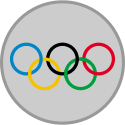Lekkoatletyka na Letnich Igrzyskach Olimpijskich 2000
| |||
(c) Brian Pracy, CC BY-SA 3.0 | |||
| Szczegóły turnieju | |||
| Miejscowość | |||
|---|---|---|---|
| Arena | |||
| Data otwarcia | 22 września 2000 | ||
| Data zamknięcia | 1 października 2000 | ||
| Liczba zawodników | 2134 | ||
| Liczba reprezentacji | 193 | ||
Lekkoatletyka na Letnich Igrzyskach Olimpijskich 2000 – zawody lekkoatletyczne podczas igrzysk w Sydney odbyły się na Stadium Australia między 22 września i 1 października.
Lekkoatletyka była największa dyscypliną podczas igrzysk – rywalizowano w 46 konkurencjach (22 kobiecych i 24 męskich). Podczas zawodów w programie igrzysk zadebiutowały dwie nowe konkurencje kobiece: skok o tyczce oraz rzut młotem – złote medale zdobyły Amerykanka Stacy Dragila oraz Polka Kamila Skolimowska, która została jednocześnie najmłodszą polską złotą medalistką olimpijską[1][2].
Rezultaty
| WR – rekord świata | OR – rekord olimpijski | NR – rekord kraju | AR – rekord kontynentu |
| PB – rekord życiowy | SB – najlepszy wynik w sezonie |
Mężczyźni
Kobiety
Klasyfikacja medalowa
| Miejsce | Reprezentacja | Złoto | Srebro | Brąz | Razem |
| 1. | 7 | 4 | 5 | 16 | |
| 2. | 4 | 1 | 3 | 8 | |
| 3. | 4 | 0 | 0 | 4 | |
| 4. | 3 | 4 | 6 | 13 | |
| 5. | 2 | 3 | 2 | 7 | |
| 6. | 2 | 2 | 2 | 6 | |
| 2 | 2 | 2 | 6 | ||
| 8. | 2 | 1 | 2 | 5 | |
| 9. | 2 | 0 | 3 | 5 | |
| 10. | 2 | 0 | 0 | 2 | |
| 11. | 1 | 3 | 0 | 4 | |
| 12. | 1 | 2 | 2 | 5 | |
| 13. | 1 | 2 | 0 | 3 | |
| 14. | 1 | 1 | 2 | 4 | |
| 15. | 1 | 1 | 0 | 2 | |
| 1 | 1 | 0 | 2 | ||
| 17. | 1 | 0 | 0 | 1 | |
| 1 | 0 | 0 | 1 | ||
| 1 | 0 | 0 | 1 | ||
| 1 | 0 | 0 | 1 | ||
| 1 | 0 | 0 | 1 | ||
| 1 | 0 | 0 | 1 | ||
| 1 | 0 | 0 | 1 | ||
| 1 | 0 | 0 | 1 | ||
| 25. | 0 | 5 | 4 | 9 | |
| 26. | 0 | 2 | 0 | 2 | |
| 0 | 2 | 0 | 2 | ||
| 28. | 0 | 1 | 3 | 4 | |
| 29. | 0 | 1 | 2 | 3 | |
| 30. | 0 | 1 | 1 | 2 | |
| 0 | 1 | 1 | 2 | ||
| 32. | 0 | 1 | 0 | 1 | |
| 0 | 1 | 0 | 1 | ||
| 0 | 1 | 0 | 1 | ||
| 0 | 1 | 0 | 1 | ||
| 0 | 1 | 0 | 1 | ||
| 0 | 1 | 0 | 1 | ||
| 0 | 1 | 0 | 1 | ||
| 39. | 0 | 0 | 2 | 2 | |
| 40. | 0 | 0 | 1 | 1 | |
| 0 | 0 | 1 | 1 | ||
| 0 | 0 | 1 | 1 | ||
| 0 | 0 | 1 | 1 | ||
| 0 | 0 | 1 | 1 |
Uwagi
- ↑ 2 sierpnia 2008 Międzynarodowy Komitet Olimpijski zdyskwalifikował formalnie sztafetę USA (skład Amerykanów: Alvin Harrison, Antonio Pettigrew, Calvin Harrison, Michael Johnson, w eliminacjach i półfinale biegli Angelo Taylor i Jerome Young). Zespół został zdyskwalifikowany przez Pettigrew, który był na dopingu, gdzie jednocześnie (oprócz dyskwalifikacji), odebrano mu złoty medal. Decyzja w sprawie ponownego przyznania medali i dyplomów zapadła na posiedzeniu MKOl-u. (1). Ostateczna decyzja w tej sprawie została podjęta 21 lipca 2012 w Londynie (2).
- ↑ a b c 5 października 2007 u amerykańskiej sprinterki – Marion Jones, dowiedziono, że przed LIO 2000 w Sydney, biegaczka była na niedozwolonych środkach dopingujących, zaś 9 października 2007 odebrano jej medale zdobyte na tych Igrzyskach. 12 października medale formalnie trafiły do MKOl-u. Jednakże MKOl nie zdecydował o ponownym przyznaniu medali, jeśli zaś miałoby tak być, medale przyznane byłyby w następujący sposób:
- 100 m
 Ekaterini Thanou 11,12
Ekaterini Thanou 11,12 Tayna Lawrence 11,18
Tayna Lawrence 11,18 Merlene Ottey 11,19
Merlene Ottey 11,19
- 200 m
 Pauline Davis-Thompson 22,27
Pauline Davis-Thompson 22,27 Susanthika Jayasinghe 22,28
Susanthika Jayasinghe 22,28 Beverly McDonald 22,35
Beverly McDonald 22,35
- Skok w dal
- ↑ a b 23 listopada 2007, IAAF zgłosiła do MKOl-u prośbę o dyskwalifikację amerykańskiej sztafety kobiet 4 × 100 i 4 × 400 m, po pozytywnym teście antydopingowym, przeprowadzonym na Marion Jones przed LIO 2000. 12 grudnia 2007, MKOl zdyskwalifikował Jones i formalnie odebrał jej medale, zaś nie zdyskwalifikował sztafety. 10 kwietnia 2008 MKOl wykluczył sztafetę oraz poprosił o zwrócenie medali. Następnie brązowe medale zostały przyznane 2 reprezentacjom, następująco: [1]
 Francja: Linda Ferga, Muriel Hurtis, Fabe Dia, Christine Arron, Sandra Citté (eliminacje) (czas: 42,42) i
Francja: Linda Ferga, Muriel Hurtis, Fabe Dia, Christine Arron, Sandra Citté (eliminacje) (czas: 42,42) i  Nigeria: Olabisi Afolabi, Charity Opara, Rosemary Okafor, Falilat Ogunkoya-Osheku, Doris Jacob (eliminacje) (czas: 3:23,80).
Nigeria: Olabisi Afolabi, Charity Opara, Rosemary Okafor, Falilat Ogunkoya-Osheku, Doris Jacob (eliminacje) (czas: 3:23,80).
Przypisy
- ↑ Skolimowska Kamila (1982-2009) (pol.). olimpijski.pl. [dostęp 2012-03-27]. [zarchiwizowane z tego adresu (13 grudnia 2013)].
- ↑ Women’s hammer throw final (ang.). iaaf.org. [dostęp 2012-03-27].
Bibliografia
- Olympic Games (Men), gbrathletics [dostęp 2011-11-09] (ang.).
- Olympic Games (Women), gbrathletics [dostęp 2011-11-09] (ang.).
- Athletics at the 2000 Sydney Summer Games, Sports-Reference.com [dostęp 2011-11-09] [zarchiwizowane z adresu 2008-09-24] (ang.).
- IAAF Athletics coverage - Sydney 2000, iaaf.org [dostęp 2011-11-15] [zarchiwizowane z adresu 2011-06-04] (ang.).
Media użyte na tej stronie
Flag of Jamaica. “The sunshine, the land is green, and the people are strong and bold” is the symbolism of the colours of the flag. GOLD represents the natural wealth and beauty of sunlight; GREEN represents hope and agricultural resources; BLACK represents the strength and creativity of the people. The original symbolism, however, was "Hardships there are, but the land is green, and the sun shineth", where BLACK represented the hardships being faced.
Autor: https://phabricator.wikimedia.org/diffusion/GOJU/browse/master/AUTHORS.txt, Licencja: MIT
An icon from the OOjs UI MediaWiki lib.
Autor: https://phabricator.wikimedia.org/diffusion/GOJU/browse/master/AUTHORS.txt, Licencja: MIT
An icon from the OOjs UI MediaWiki lib.
Autor: maix¿?, Licencja: CC BY-SA 2.5
A gold medal with the olympic rings inside
Autor: maix¿?, Licencja: CC BY-SA 2.5
A silver medal with the olympic rings inside
Autor: maix¿?, Licencja: CC BY-SA 2.5
A bronze medal with the olympic rings inside
The flag of Navassa Island is simply the United States flag. It does not have a "local" flag or "unofficial" flag; it is an uninhabited island. The version with a profile view was based on Flags of the World and as a fictional design has no status warranting a place on any Wiki. It was made up by a random person with no connection to the island, it has never flown on the island, and it has never received any sort of recognition or validation by any authority. The person quoted on that page has no authority to bestow a flag, "unofficial" or otherwise, on the island.
Flag of Ethiopia
Flaga Finlandii
Flag of Portugal, created by Columbano Bordalo Pinheiro (1857-1929), officially adopted by Portuguese government in June 30th 1911 (in use since about November 1910). Color shades matching the RGB values officially reccomended here. (PMS values should be used for direct ink or textile; CMYK for 4-color offset printing on paper; this is an image for screen display, RGB should be used.)
Autor: Pedro A. Gracia Fajardo, escudo de Manual de Imagen Institucional de la Administración General del Estado, Licencja: CC0
Flaga Hiszpanii
Pictograms of Olympic sports – . This is an unofficial sample picture. Images of official Olympic pictograms for 1948 Summer Olympics and all Summer Olympics since 1964 can be found in corresponding Official Reports.
Olympic Rings without "rims" (gaps between the rings), As used, eg. in the logos of the 2008 and 2016 Olympics. The colour scheme applied here pertains to the 2016 Olympics in Rio de Janeiro.
Olympic Rings without "rims" (gaps between the rings), As used, eg. in the logos of the 2008 and 2016 Olympics. The colour scheme applied here pertains to the 2016 Olympics in Rio de Janeiro.
(c) Brian Pracy, CC BY-SA 3.0
Final of the women’s long jump competition at the 2000 Summer Olympics in Sydney




















































